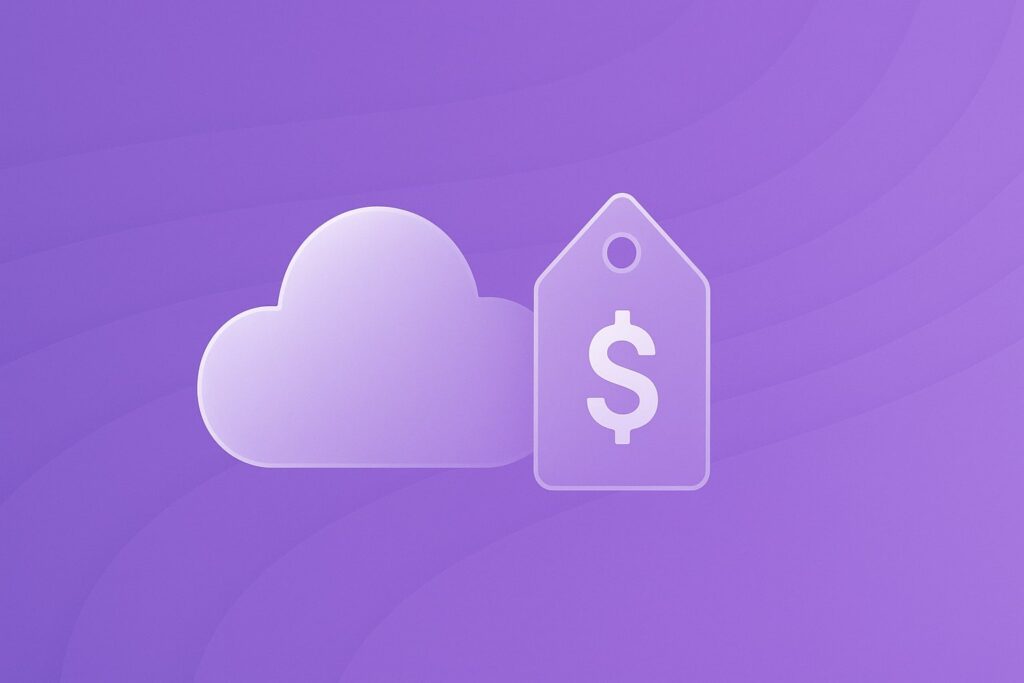Cloud hosting costs and cloud storage costs both hinge primarily on the volume of data being stored and transferred
You wake up in the morning to an alert: your cloud spend doubled overnight.
What happened?
Well, multiple tests were left running with no one to keep them in check.
It’s that simple.
And you’re not alone.
Recent data shows that about 30% of cloud spend is wasted. But, you’ve got to spend, right? The cloud is one of the great tech innovations of the 21st century. It’s triggered a paradigm shift in your daily workload for businesses across the globe.
You’ll get massive storage capacities at low cost and virtual machines plugging away at calculations. The cloud can cut down on expenses and offload work. So business is more efficient from multiple angles.
But if you want to migrate to the cloud, you’ll need careful planning. Cloud hosting costs can quickly add up. You’ll want to know what affects the price of cloud resources like computing and storage. It can help you find the most efficient solution.
Key Takeaways
- Cloud pricing is highly variable and depends on your usage patterns, configurations, and pricing models.
- Storage expenses go beyond simple volume because access frequency and data retrieval play a major role.
- Hybrid cloud approaches and DevOps automation tools like DuploCloud can help control costs monthly.
Private, Public, and Hybrid Cloud Hosting Costs
There are three approaches businesses can use to incorporate the cloud into storage and hosting. The first is the creation of a private cloud owned and operated by the business itself.
This solution can be attractive to businesses that:
- Need particularly low latency responses
- Want to maintain dedicated infrastructure and avoid multi-tenancy issues
- Care to keep the entire tech stack in-house for whatever reason
Those are all legitimate reasons to operate a private cloud for your business. But they must be weighed against the costs of doing so. These clouds require heavy upfront investment in server infrastructure and the staff to service it.
Once the cloud servers are live, your business is responsible for making sure they stay active and available as much as possible.
If your servers contain client info such as payment or protected health information, they must also meet the strict security requirements.
These are set forth by the Payment Card Industry Security Standards Council.
They’re also laid out in the Health Insurance Portability and Accountability Act (HIPAA), among other possible standards.
An analysis by Sherweb found that a small business would likely pay an average of $1,476.31 per month for a private cloud on-premise.
Public clouds are what most people think of when they consider the cloud. Servers operated by Platform-as-a-Service (PaaS) companies such as Heroku and Google Cloud.
With these cloud services, your business pays for the amount of cloud computing and storage it requires. And you pass on to the provider the onus for:
- Availability
- Operation
- Maintenance
- Security
Cloud storage costs and cloud computing hosting costs can be significantly lower when using one of these services. This is especially true in the short term. However, if the cloud service goes down, your business may lose business data and productivity while you wait for it to be restored.
Sherweb’s analysis estimated that a small business with the same configuration would pay $313.90 per month using a public cloud solution.
A hybrid cloud approach keeps some services and applications on private cloud servers and others on public ones. This approach allows businesses with sudden spikes in activity to scale up their public cloud use ad hoc. At the same time, they can maintain a private cloud as a baseline.
For businesses looking to move functionality to the cloud, the hybrid approach allows for control of the pace of the shift. That’s critical, as migrating to the cloud requires rigorous preparation and lockstep cooperation across the company. We’ve created a free resource to provide a guiding framework for a smooth transition.
Download the Essential Cloud Migration Checklist for free. It will help ensure your team remains goal-oriented and aligned throughout the migration process.
Breaking Down Cloud Hosting Costs
Cloud hosting costs are typically charged by the hour or by the second. Your rates are set by the provider. Several factors can affect that rate.
They typically include:
- The number of virtual CPUs used
- Total memory
- Network performance
- Region
- Host operating system
As an example cloud provider, let’s look at Amazon cloud storage costs.
You’d be:
- Using the AWS offering Elastic Compute Cloud (EC2). This is a cloud server using one vCPU with 2GB of memory and network performance of up to 10 GB.
- Running on Linux and operating out of Ohio.
This would cost $0.0255 per hour using on-demand pricing.
On the other end of the spectrum, an instance running 128 vCPU with 4,096 GiB of memory running on Windows and operating out of Northern California would cost $40.568 per hour. Generally speaking, higher performance in more desirable regions costs more.
Additional variables can also affect hosting costs:
- Storage type (e.g., SSD vs. HDD)
- Instance availability (dedicated vs. shared)
- Data transfer volumes
It’s important to consider usage patterns, like peak load times, idle server periods, or the need for high availability. These will impact whether on-demand, reserved, or spot instances offer the best value.
Pricing Models
Cloud hosting costs break down further according to the pricing model you select. Most businesses offer at least two pricing models for hosting: on-demand and reserved instances.
The on-demand model is the most flexible. It allows you to pay only for the hosting and computing you need when you need it.
That flexibility tends to come at a greater cost. But it can be especially useful for test periods or applications with highly variable computing demands.
Reserved instances, however, represent dedicated hosting or computing capacity. Your business commits to using this for a one- or three-year period. When deployed carefully, reserved instances can help lower the price per hour of your cloud usage. That makes them well-suited to applications that face stable demand.
Providers are also typically happy to sell you additional on-demand capacity if demand spikes. However, failing to use all the computing you’ve paid for can result in inefficiencies.
Some providers, such as AWS, also offer a third model, which Amazon refers to as Spot Instances. These are EC2 instances that aren’t actively in use but that don’t provide the same availability as standard, on-demand instances. As a result, they’re best suited to stateless, fault-tolerant, or flexible applications. They can be deployed to launch hyperscale workloads at affordable prices, up to 90%, per Amazon.
Breaking Down Cloud Storage Costs
The storage needs of a company are often quite different from those of the consumer. Amazon Cloud Drive costs $6.99 a month for 1TB of storage. But the amount of data a business handles often exceeds the capacity of end-user cloud storage solutions.
With Amazon Simple Storage (S3), for instance, you’ll pay $0.023 per GB per month for the first 50TB you store. That price goes down as you scale your storage needs up to 500 TB, with the per GB rate dropping to $0.021. The average storage costs for cloud SaaS come to around $11.64 per employee.
What can drive your costs up, however, is how often you use the files you store in the cloud. Providers typically charge for each operation you perform on files you’ve stored, but those rates vary according to the type of storage you select.
Hot storage costs more per GB, but charges less for each operation. Cold storage inverts that price relationship. Amazon doesn’t make this delineation. But with Microsoft Azure, hot storage begins at $0.018 per GB for the first TB. What’s more, archive storage can go as low as $0.00099 per GB. Reserved options can also be purchased for storage on one- or three-year terms, offering reduced rates.
Some providers charge a fee for removing more than a certain amount of data from storage, no matter the activity level. In Amazon’s case, taking more than 1GB of data out of S3 in a single month incurs a fee.
Power Efficient Cloud Computing with DuploCloud
No matter which mixture of cloud hosting and storage you choose, you can reduce your costs with the deployment optimization powers of DuploCloud.
We designed our all-in-one DevOps Automation platform to automatically supply secure, compliant infrastructure. That helps accelerate deployment, cut down on human error, and ultimately reduce development costs by as much as 75%.
DuploCloud stands out by offering an AI approach to DevOps. This makes it accessible even for teams without deep cloud expertise. It integrates seamlessly with AWS, Azure, and GCP, handles compliance out of the box (HIPAA, SOC 2, PCI-DSS), and empowers teams to scale faster while keeping cloud spending under control.
Contact us today for a free demo.
FAQs for Cloud Hosting Costs
What’s the difference between cloud hosting and cloud storage?
Cloud hosting refers to using virtual servers to run applications or websites. Cloud storage involves saving files and data in remote servers. Hosting typically includes compute resources like CPU and memory. At the same time, storage is about data capacity and retrieval speed.
How can I estimate my monthly cloud costs?
Most cloud providers offer cost calculators (e.g., AWS Pricing Calculator, Google Cloud Pricing Tool) to estimate monthly cloud costs. This will be based on your expected usage. You’ll need to know your compute, storage, and network needs to get an accurate estimate.
Is a private cloud ever cost-effective for small businesses?
A private cloud can be cost-effective for businesses with strict compliance needs or highly predictable workloads. But it requires significant upfront investment and ongoing maintenance. For most small businesses, a public or hybrid model offers better flexibility and cost efficiency.
What’s the best way to reduce cloud costs without sacrificing performance?
- Leverage reserved or spot instances where appropriate
- Use cold or archive storage for infrequently accessed data
- Implement automation platforms like DuploCloud
This will help you optimize resource provisioning and compliance. So you’ll cut cloud costs and unnecessary spending.
How do data-egress fees impact overall cloud storage cost?
Data egress (the cost of moving data out of a cloud provider’s region or service) can significantly raise your cloud bill. This is especially true if you frequently transfer large volumes of data. Even if your storage per GB is low, repeated retrieval, cross-region replication, or serving large data sets can add significant network charges.
So be sure to check your provider’s egress tiers, region-based pricing, and any “free outbound” allowances. Then use this as part of your cost-forecasting model.
What role does lifecycle management of storage play in cost optimization?
Lifecycle management lets you tier your data from high-cost, high-access “hot” storage to lower-cost, infrequently accessed “cold” or “archive” storage. You’ll want to make sure you’re properly architecting access latency, retrieval frequency, and compliance requirements. That way, you can lower your per-GB cost for data that doesn’t need instant access. The savings magnify as data volume grows, but mis-tiering can hurt your performance and cost.



